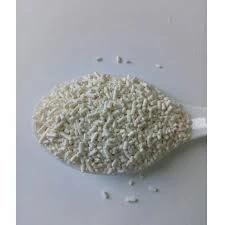
Exploring the Benefits and Uses of E965 Sweetener in Food Products
Understanding E965 Sweetener Uses, Benefits, and Considerations
E965, commonly known as maltitol, is a sugar alcohol widely used as a sweetener in various food products. It is often found in sugar-free and reduced-calorie foods due to its lower caloric content compared to regular sugar (sucrose). Maltitol has a sweetness level comparable to sucrose, making it an attractive option for those seeking to reduce sugar intake without sacrificing taste. This article explores the uses, benefits, and considerations of E965 as a sweetening agent.
What is E965 (Maltitol)?
Maltitol is derived from maltose, which comes from starches, primarily corn or wheat. It is classified as a polyol, or sugar alcohol—compounds that have a similar chemical structure to sugars but with different properties. Maltitol appears as a white crystalline powder and is often used in combination with other sweeteners to enhance flavor and texture in various applications.
Uses of E965
Maltitol is commonly used in the production of sugar-free products, including
- Confectionery It is widely found in candies, chocolates, and gum, where it provides sweetness without the high calories of traditional sugar. - Baked Goods Maltitol is a popular ingredient in sugar-free baked items like cookies, cakes, and pastries. It helps to retain moisture, enhancing the texture of these products.
- Dairy Products Many yogurt and ice cream brands utilize maltitol to cater to health-conscious consumers desiring lower-sugar options.
- Health Foods Nutritional bars and shakes often contain E965 to provide a sweet taste while limiting caloric intake.
Benefits of E965
e965 sweetener

1. Lower Caloric Content One of the main advantages of maltitol is its lower caloric count, providing approximately 2.1 calories per gram compared to 4 calories per gram for regular sugar. This makes it ideal for weight management and diabetic-friendly diets.
2. Dental Benefits Since maltitol does not contribute to tooth decay—unlike traditional sugars—it is often recommended for individuals concerned about oral health. Its non-cariogenic properties make it a safer alternative for sweetening foods.
3. Blood Sugar Levels Maltitol has a lower glycemic index than sucrose, resulting in a more gradual increase in blood glucose levels. This characteristic is particularly beneficial for individuals with diabetes who need to monitor their sugar intake.
4. Taste Profile Many users appreciate that maltitol closely mimics the taste and texture of sugar, allowing for a more satisfying experience in food products without the associated calories.
Considerations and Potential Side Effects
While E965 offers many benefits, it is essential to consider potential side effects. As a sugar alcohol, maltitol can cause gastrointestinal discomfort, especially when consumed in large amounts. Some individuals may experience bloating, gas, and a laxative effect. It is generally recommended to consume maltitol in moderation, particularly for those who are sensitive to sugar alcohols.
Additionally, while maltitol is considered safe for use by regulatory agencies such as the FDA and EFSA, some people may still prefer to avoid artificial sweeteners and sugar alcohols altogether for health or dietary reasons.
Conclusion
E965 (maltitol) is a versatile sweetener that provides a satisfying alternative to traditional sugar, especially for individuals seeking to reduce caloric intake or manage blood sugar levels. Its widespread use in various food products speaks to its popularity among consumers. However, as with any ingredient, moderation is crucial. Understanding both the benefits and considerations associated with E965 can help individuals make informed dietary choices that align with their health goals. Whether used in a sugar-free candy or a low-calorie dessert, maltitol remains a significant player in the world of sweeteners.
-
Why Glacial Acetic Acid Food Grade Is Essential in FlavorNewsMay.26,2025
-
Surging Export Growth of Food Additives in ChinaNewsMay.26,2025
-
How Ammonium Nitrate Fertilizer Boosts Crop YieldsNewsMay.26,2025
-
How 1,2,3-Benzotriazole Shields Plastics from UV DegradationNewsMay.26,2025
-
Cyanide in Gold Mining: Protecting People and the PlanetNewsMay.26,2025
-
Aluminum Hydroxide in Modern Sunscreen FormulationsNewsMay.26,2025
-
Understanding Synthetic Rubber OptionsNewsApr.27,2025
Hebei Tenger Chemical Technology Co., Ltd. focuses on the chemical industry and is committed to the export service of chemical raw materials.
-

view more DiethanolisopropanolamineIn the ever-growing field of chemical solutions, diethanolisopropanolamine (DEIPA) stands out as a versatile and important compound. Due to its unique chemical structure and properties, DEIPA is of interest to various industries including construction, personal care, and agriculture. -

view more TriisopropanolamineTriisopropanolamine (TIPA) alkanol amine substance, is a kind of alcohol amine compound with amino and alcohol hydroxyl, and because of its molecules contains both amino and hydroxyl. -

view more Tetramethyl Thiuram DisulfideTetramethyl thiuram disulfide, also known as TMTD, is a white to light-yellow powder with a distinct sulfur-like odor. It is soluble in organic solvents such as benzene, acetone, and ethyl acetate, making it highly versatile for use in different formulations. TMTD is known for its excellent vulcanization acceleration properties, which makes it a key ingredient in the production of rubber products. Additionally, it acts as an effective fungicide and bactericide, making it valuable in agricultural applications. Its high purity and stability ensure consistent performance, making it a preferred choice for manufacturers across various industries.











